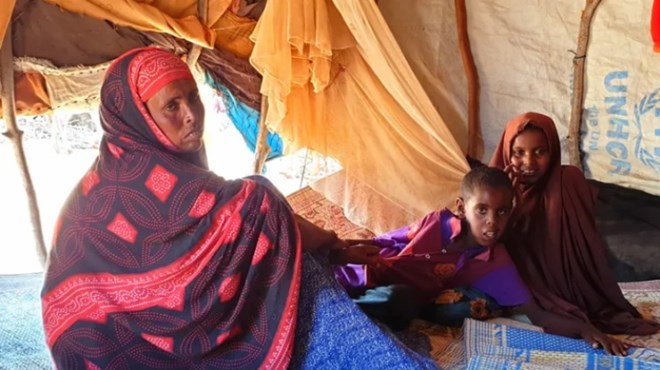
Thursday May 23, 2019
By Rebecca Root Istar Khalif, a single mother to three children, is one of 350 families at Khayrdoon camp in Puntland state, Somalia. They came to this camp for displaced people during the last drought in 2017 after all of their livestock perished. They expected to return to their village once “things got better.” Photo by: Somalia NGO Consortium.
Istar Khalif, a single mother to three children, is one of 350 families at Khayrdoon camp in Puntland state, Somalia. They came to this camp for displaced people during the last drought in 2017 after all of their livestock perished. They expected to return to their village once “things got better.” Photo by: Somalia NGO Consortium.
BARCELONA — Somalia’s aid community has been caught off guard by severe drought conditions and growing food insecurity, and now says time is ticking to raise awareness of a looming crisis.
advertisements
“This is a little bit of an unanticipated shock,” said Justin Brady, head of the United Nations Office for the Coordination of Humanitarian Affairs in Somalia. The country has persistently suffered from poor rainfall but experts were expecting an average rainy season this year.While there has been rain in recent weeks, the season is coming to an end, with the country only having seen a fraction of its expected precipitation — due in part to cyclones in the Indian Ocean that prevented rains from moving north. This has put 1.7 million people in danger of acute food shortages, while a total of 4.9 million do not have access to enough food.
“At the beginning of the season, we were told it could be delayed by a week or two, and then it became clear that it was more than just a delay and the whole rainy season was in jeopardy,” Brady said, adding that UNOCHA had even deployed staff to help with the emergency response in Mozambique, thinking they had capacity to provide support elsewhere but had to recall them when the situation deteriorated.
“The idea now is to raise awareness — not just internationally but within the country — and make sure everyone understands that we are approaching a crisis; while not necessarily on the same level as 2017, we could approach it,” Brady said.
Six years after famine claimed over 210,000 lives, 2017 marked three consecutive seasons of failed rains for the country. Another famine was avoided, but the cyclical droughts and water scarcity have prevented Somalia from rebuilding its agricultural capacity and continue to threaten with hunger and malnutrition.
Richard Desgagné, communication and prevention coordinator of the International Committee of the Red Cross’ Somalia delegation, said consequences could be more serious this time because communities haven’t had time to recover.
According to a report by the Food Security and Nutrition Analysis Unit and Famine Early Warning System Network, if rainfall remains below average through June, widespread crop failure may result in deficits of over 50%, livestock will be lost, and there will be worsening of food security leading to increased displacement.
With the crisis arriving unexpectedly, humanitarians said the international aid community’s eyes were elsewhere. “There’s been very little coverage up until now, mostly because of the cyclone” that hit southern Africa in March, Desgagné said. “The [spot]light has not been on the Horn of Africa.”
The U.N. has said $710 million is required by the end of the year to avoid a crisis.
But aid workers say that, so far, commitments haven’t been high enough. “We must strengthen our efforts and increase resources in responding to the needs of families and minimize human suffering,” said Nasra Ismail, director at the Somalia NGO Consortium. “Without an urgently scaled-up response, the impact of this drought will be severe.”
Brady emphasized that investment isn’t just needed for humanitarian aid but development efforts too, calling the current health system unsustainable and dysfunctional given its reliance on humanitarian groups for everyday services.
“Humanitarian funding and solutions are not a replacement for a health sector, so we really need to see resources coming from the development side to allow the health sector to function properly,” he said.